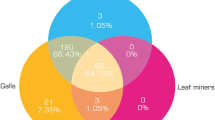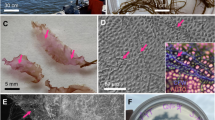Abstract
In the nort-western region of Venezuela, Phyllocoptruta oleivora, Tetranychus mexicanus and Brevipalpus phoenicis are common plant-feeding mites on leaves, fruits and branches of Tahiti lime, Citrus latifolia. The population dynamics of these herbivores are affected by many factors, such as weekly treatments with wettable sulphur, particularly during the wet season, maintenance pruning of plants, irrigation with microsprinklers, induction of water stress by withholding irrigation and biotic and abiotic environmental factors. During October 1994-January 1995, 31 trees in a commercial orchard were sampled weekly in order to describe population fluctuations of plant-feeding mites (mean number of mites per leaf or fruit), before (4 weeks) and after (4 weeks) a period of 6 weeks of drought stress (no irrigation). The population density of P. oleivora increased progressively during the last 3 weeks of the irrigation period and reached a maximum of 24 mites per fruit. In contrast, the populations of the other two species, T. mexicanus and B. phoenicis, remained at the same low density as before the withholding-irrigation period. After 6 weeks without irrigation, only T. mexicanus increased, to a high mean value of 11 mites per leaf. The withholding-irrigation practice appears to affect the population size of P. oleivora towards the end of this period and that of T. mexicanus at the beginning of the re-establishment of the water supply. The highest proportion of trees (32%) was infested by T. mexicanus after the withholding-irrigation period, when irrigation was resumed, whereas the highest levels of infestation of trees by P. oleivora and B. phoenicis were 16 and 10%, respectively, during the last week of the water-stress period. Although factors affecting the dynamics of the mites in the orchard are likely to be complex, irrigation management apparently plays an important role.
Similar content being viewed by others
References
Abou-Setta, M.M. and Childers, C.C. 1989. Biology of Euseius mesembrinus (Acari: Phytoseiidae): life tables and feeding behavior on tetranychid mites on citrus. Environ. Entomol. 18(4): 665–669.
Allen, J.C. 1976. A model for predicting citrus rust mite damage on Valencia orange fruit. Environ. Entomol. 5: 1083–1085.
Allen, J.C. 1978. The effect of citrus rust mite damage on citrus drop. J. Econ. Entomol. 71: 746–750.
Allen, J.C. 1979. The effect of citrus rust mite damage on citrus tree growth. J. Econ. Entomol. 72: 195–201.
Allen, J.C. and Stamper, J.H. 1979. Frequency distribution of citrus rust mite damage on citrus fruit. J. Econ. Entomol. 72: 327–330.
Beattie, G.A., Roberts, E.A., Vanhoff, C.L. and Flack, L.K. 1991. Effects of climate, natural enemies and biocides on three citrus mites in coastal New South Wales. Exp. Appl. Acarol. 11(4): 271–295.
Campbell, C.W. 1979. Tahiti Lime Production in Florida. Fla. Coop. Ext. Serv. Inst. Food Agric. Sci. Bull. 187.
Ewel, J.J., Madriz, A. and Tosi, J.A. 1979. Zonas de Vida de Venezuela. Memoria Descriptiva Sobre el Mapa Ecológico. Edit. Sucre, Caracas, Venezuela.
Gravena, S., Coletti, A. and Yamamoto, P.T. 1993. Influence of green cover with Ageratum conyzoides and Eupatorium pauciflorum on predatory and phytophagous mites in citrus. Bull. Oilb. Srop. 16(7): 104–114.
Huan, F.N., Li, L.S. and Chen, J.L. 1992. A preliminary study on the damage and action threshold of citrus rust mite to citrus. Acta Phytophylacica Sinica 19(3): 223–230.
Keifer, H.H., Baker, E.W., Kono, T., Delfinado, M. and Styer, W. 1982. An Illustrated Guide to Plant Abnormalities Caused by Eriophyid Mites in North America. US Department of Agriculture.
Knapp, J.L., Fasulo, T.R. and Tucker, D.P. 1982. The effects of different irrigation and weed management practices on mite populations in a citrus grove. Proc. Fla. State Horticult. Soc. 95: 47–50.
Li, L.S., Huang, F.N. and Chen, J.L. 1989. Ecological characteristics of the citrus rust mite, Phyllocoptruta oleivora (Ashm.). Acta Entomol. Sinica 32(2): 184–191.
McCoy, C.W. 1977. Horticultural practices affecting phytophagous mite populations on citrus. Proc. Int. Soc. Citricult. 2: 459–462.
McCoy, C.W. and Albrigo, L.G. 1975. Feeding injury to the orange caused by the citrus rust mite, Phyllocoptruta oleivora (Prostigmata: Eriophyoidea). Ann. Entomol. Soc. Am. 68: 289–297.
Mora, J. 1987. Dinámica poblacional de ácaros siguiendo la fenología de 25 arboles de Naranjo, Citrus sinensis (L.) Osbeck, clon Valencia. Centro Agrícola (Cuba) 14(3): 3–14.
Mora, J. and Aragon, P. 1987. Dinámica de las poblaciones del ácaro del moho Phyllocoptruta oleivora (Ashmead) en hojas inmaduras y hojas adultas de lima persa Citrus aurantifolia (L.) Swingle. Centro Agrícola, (Cuba) 14(1): 31–37.
Mora, J. and Cepero, H. 1987. Nuevo muestreo para el estudio de la dispersión del caro del moho Phyllocoptruta oleivora (Ashmead) en una plantación de Naranjo Valencia. Centro Agrícola (Cuba) 14(3): 62–72.
Muma, M.H. 1955. Factors contributing to the natural control of citrus insects and mites in Florida. J. Econ. Entomol. 48(4): 432–438.
Muma, M.H. 1961. The influence of cover crop cultivation on populations of injurious insects and mites in Florida citrus groves. Fla. Entomol. 44: 61–68.
Muma, M.H. 1965. Populations of common mites in Florida citrus groves. Fla. Entomol. 48: 35–46.
Ochoa, R., Aguilar, H. and Vargas, C. 1991. Acaros fitofagos de America Central: Guia Ilustrada. CATIE, Costa Rica.
Osburn, M.R. and Mathis, W. 1944. Effect of cultural practices on the citrus rust mite. J. Econ. Entomol. 37: 767–770.
Peña, J.E. and Baranowski, B.M. 1990. Dispersion indices and sampling plans for the broad mite (Acari: Tarsonemidae) and the citrus rust mite (Acari: Eriophyidae) on limes. Environ. Entomol. 19(2): 378–382.
Quirós-Gonzales, M. 1996. Plant feeding mites on orchards under irrigation of Tahiti lime, Citrus latifolia Tanaka, in Zulia State, Venezuela. In: Acarology, IX: Volume 1, Proceedings, R. Mitchell, D.J. Horn, G. Needham and C. Welbourn (eds), pp. 203–205. Ohio Biological Survey, Columbus, OH.
Yang, Y., Allen J.C., Knapp, J.L. and Stansly, J.A. 1994. Citrus rust mite (Acari: Eriophyidae) damage effects on Hamlin orange fruit growth and drop. Environ. Entomol. 23(2): 244–247.
Yothers, W.W. 1918. Some Reasons for Spraying to Control Insect and Mite Enemies of Citrus Trees in Florida. US Department of Agriculture.
Wolfenbarger, D.O. 1974. Incidence and control of the broad mite on lime in Florida. Ceiba 18: 70–74.
Author information
Authors and Affiliations
Rights and permissions
About this article
Cite this article
Quiros-Gonzalez, M. Phytophagous Mite Populations on Tahiti Lime, Citrus Latifolia, Under Induced Drought Conditions. Exp Appl Acarol 24, 897–904 (2000). https://doi.org/10.1023/A:1010744009094
Issue Date:
DOI: https://doi.org/10.1023/A:1010744009094




